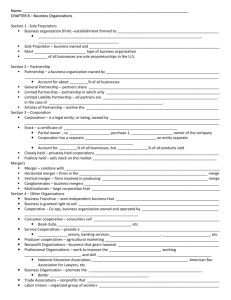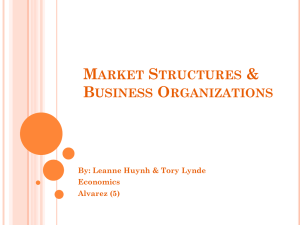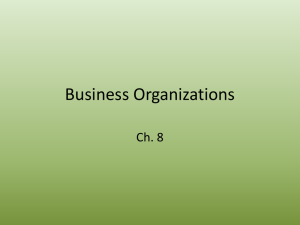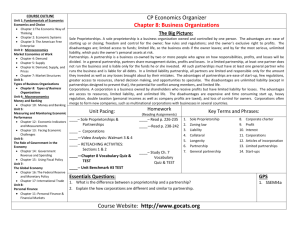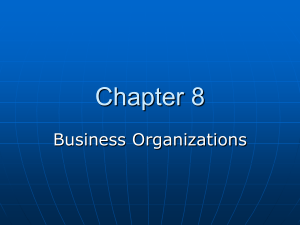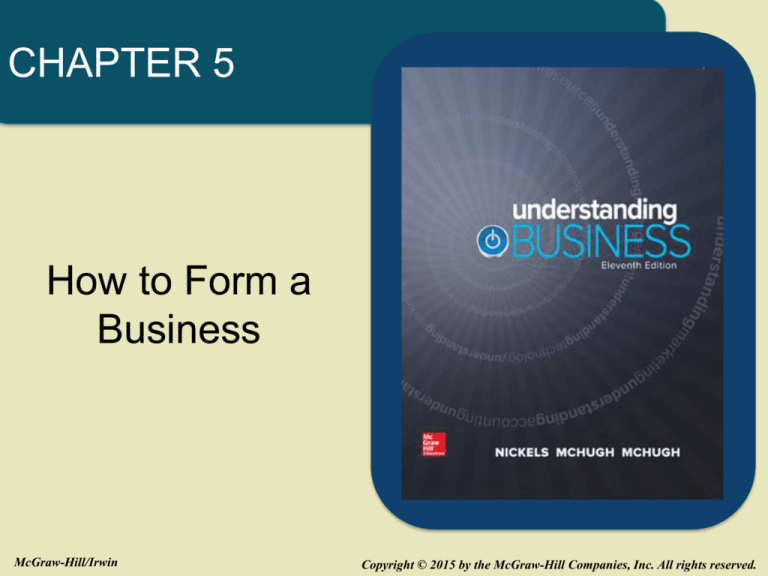
CHAPTER 5
How to Form a
Business
McGraw-Hill/Irwin
Copyright © 2015 by the McGraw-Hill Companies, Inc. All rights reserved.
LEARNING OBJECTIVES
1. Compare the advantages and disadvantages of sole
proprietorships.
2. Describe the differences between general and
limited partners, and compare the advantages and
disadvantages of partnerships.
3. Compare the advantages and disadvantages of
corporations and summarize the differences
between C corporations, S corporations and limited
liability companies.
5-2
LEARNING OBJECTIVES
4. Define and give examples of three types of corporate
mergers, and explain the role of leveraged buyouts
and taking a firm private.
5. Outline the advantages and disadvantages of
franchises, and discuss the opportunities for diversity
in franchising and the challenges of global
franchising.
6. Explain the role of cooperatives.
5-3
ANNE BEILER
Auntie Anne’s
• Started selling pretzels when
her family was living paycheck
to paycheck.
• Now Auntie Anne’s has over
1,200 locations and brings in
over $410 million!
• Beiler sold the company in
2005 to start focusing on
charity work.
5-4
NAME that COMPANY
In 2013, this company became the largest firm in
terms of revenue to be taken private through a
leveraged buyout. After closing the $25 million
deal, the founder now controls a 75% stake of
the company he started in his dorm room.
Name that company!
5-5
MAJOR FORMS of OWNERSHIP
• Sole Proprietorship -- A business owned, and
usually managed, by one person.
• Partnership -- Two or more people legally agree to
become co-owners of a business.
• Corporation -- A legal entity with authority to act
and have liability apart from its owners.
5-6
FORMS of
BUSINESS OWNERSHIP
5-7
ETHNIC BUSINESS CENTERS
Cities with the Most Minority-Run Firms
1. Atlanta, GA
2. Baltimore, MD
3. Nashville, TN
4. Houston, TX
5. Miami - Ft.
Lauderdale, FL
Source: Forbes, www.forbes.com, accessed November 2014.
Photo Credit: James Rintamaki
5-8
MAJOR BENEFITS of SOLE
PROPRIETORSHIP
LO 4-1
1) Ease of starting and
ending the business
2) Being your own boss
3) Pride of ownership
4) Leaving a legacy
5) Retention of company
profit
6) No special taxes
5-9
DISADVANTAGES of SOLE
PROPRIETORSHIPS
LO 4-1
1) Unlimited Liability -- Any debts or damages
incurred by the business are your debts, even if it
means selling your home, car or anything else.
2) Limited financial resources
3) Management difficulties
4) Overwhelming time commitment
5) Few fringe benefits
6) Limited growth
7) Limited life span
5-10
WORK-LIFE BALANCING ACT
% of small business owners
Work over 80 hours per week
Source: Inc., www.inc.com, accessed November 2014.
Work over 40 hours per week
5-11
TEST PREP
• Most people who start businesses in the U.S. are
sole proprietors. What are the advantages and
disadvantages of sole proprietorships?
• Why would unlimited liability be considered a
major drawback to sole proprietorships?
5-12
MAJOR TYPES of PARTNERSHIPS
LO 4-2
• General Partnership -- All owners share in
operating the business and in assuming liability for
the business’s debts.
• Limited Partnership -A partnership with one or
more general partners and
one or more limited
partners.
5-13
TYPES OF PARTNERS
LO 4-2
• General Partner -- An owner (partner) who has
unlimited liability and is active in managing the firm.
• Limited Partner -- An owner who invests money in
the business, but enjoys limited liability. Limited
Liability means that liability for the debts of the
business is limited to the amount the limited partner
puts into the company; personal assets are not at
risk.
5-14
OTHER FORMS of
PARTNERSHIPS
LO 4-2
• Master Limited Partnership -- A partnership that
looks much like a corporation, but is taxed like a
partnership and thus avoids the corporate income
tax.
• Limited Liability Partnership -- Limits partners’
risk of losing their personal assets to the outcomes of
only their own acts and omissions and those of
people under their supervision.
5-15
ADVANTAGES of
PARTNERSHIPS
LO 4-2
• More financial
resources
• Shared
management and
pooled/complement
ary skills and
knowledge
• Longer survival
• No special taxes
5-16
DISADVANTAGES of
PARTNERSHIPS
LO 4-2
• Unlimited liability
• Division of profits
• Disagreements among
partners
• Difficult to terminate
5-17
PICKING YOUR PARTNER
LO 4-2
There is no such thing as a perfect partner but
ask these questions when you try to find your
best match:
• Do you share the same goals?
• Do you share the same vision for the company?
• What skills does he/she have? Are yours the same?
• What can he/she bring to the business?
• What type of decision maker is he/she?
• Do you trust each other?
• How does he/she problem solve?
5-18
GOOD BUSINESS,
BAD KARMA?
Imagine you and your partner own a construction
company. You receive a subcontractor’s bid you
know is 20% too low. This could potentially put the
subcontractor out of business. Accepting the bid
will improve your chances of getting a big job.
Your partner wants to take the bid:
• What do you think you should do?
• What will be the consequences of your decision?
5-19
TEST PREP
• What’s the difference between a limited partner
and a general partner?
• What are some of the advantages and
disadvantages of partnerships?
5-20
CONVENTIONAL
CORPORATIONS
LO 4-3
• Conventional (C)
Corporation -- A statechartered legal entity with
authority to act and have
liability separate from its
owners (its stockholders).
5-21
ADVANTAGES of
CORPORATIONS
LO 4-3
• Limited liability
• Ability to raise more money for investment
• Size
• Perpetual life
• Ease of ownership change
• Ease of attracting talented employees
• Separation of ownership from management
5-22
HOW OWNERS AFFECT
MANAGEMENT
LO 4-3
5-23
The BIG BOYS of BUSINESS
LO 4-3
America’s Largest Corporations
1. Walmart
2. Exxon Mobil
3. Chevron
4. Berkshire
Hathaway
Photo Credit: Walmart Stores
5. Apple
Source: Fortune, www.fortune.com, accessed November 2014.
5-24
PRIVACY PLEASE
LO 4-3
The Ten Largest Private Corporations in the U.S.
Company
State
Industry
Cargill
MN
Farming
Koch Industries
KS
Chemicals
Dell
TX
Computers
Bechtel
CA
Construction
PricewaterhouseCoopers
NY
Business Services
Mars
VA
Food
Pilot Flying J
TN
Convenience Stores
Publix Supermarkets
FL
Grocery
Ernst & Young
NY
Business Services
C&S Wholesale Grocers
NH
Food Wholesale
Source: Forbes, www.forbes.com, accessed November 2014.
5-25
DISADVANTAGES of
CORPORATIONS
LO 4-3
• Initial cost
• Extensive paperwork
• Double taxation
• Two tax returns
• Size
• Difficulty of termination
• Possible conflict with
stockholders and board of
directors
5-26
EVEN the BIG GUYS
MAKE MISTAKES
LO 4-3
Company
Bad Move
Atari
The amount of surplus from a bad game was so big,
the copies had to be buried in a New Mexican
landfill.
Blockbuster
Passed on a partnership with Netflix and ended up
going bankrupt in 2011.
Coca-Cola
New Coke lasted only 77 days because Coca-Cola
received more than 1,500 complaint calls a day.
Pan American World
Airways
After the bombing of Flight 103, the airline blamed
the government after the victims’ families filed a
$300 million lawsuit.
Pets.com
Debuted with a $3 million Super Bowl ad and a
Macy’s Thanksgiving Day Parade float. Nine months
later, they went bankrupt.
Source: Bloomberg Businessweek, www.businessweek.com, accessed November 2014.
5-27
B CORPORATIONS LET
SUSTAINABILITY SET SAIL
• Michael Dimin saw tons of
fish were left to rot after
fishermen caught too much.
• Registered his company,
Sea2Table as a benefit
corporation.
• B-corporations are judged on
how they meet their own set
of socially or environmentally
beneficial goals.
5-28
WHO CAN INCORPORATE?
LO 4-3
• Anyone - truckers, doctors, plumbers, athletes
and small business owners can incorporate.
• Normally stock is not issued to outsiders when
individuals incorporate, so the advantages and
disadvantages are not exactly the same as for
large corporations.
• Major advantages are limited liability and possible
tax benefits.
5-29
OLDIES BUT GOODIES
LO 4-3
America’s Oldest Corporations
Company
Year Started
Type of Company
J.E. Rhoads & Sons
1702
Conveyer Belts
Covenant Life
Insurance
1717
Insurance
Philadelphia
Insurance
1752
Insurance
Contributorship
Dexter
1767
Adhesives & Coatings
D. Landreth Seed
1784
Seeds
Bank of New York
1784
Banking
5-30
S CORPORATIONS
LO 4-3
• S Corporation -- A unique government creation that
looks like a corporation, but is taxed like sole
proprietorships and partnerships.
• S corporations have shareholders, directors and
employees, plus the benefit of limited liability.
• Profits are taxed only as the personal income of
the shareholder.
5-31
WHO CAN FORM
S CORPORATIONS?
LO 4-3
• Qualifications for S Corporations:
-
Have no more than 100 shareholders.
-
Have shareholders that are individuals or estates and
are citizens or permanent residents of the U.S.
-
Have only one class of stock.
-
Derive no more than 25% of income from passive
sources.
• If an S corporation loses its S status, it may not
operate under it again for at least 5 years.
5-32
LIMITED LIABILITY COMPANIES
LO 4-3
• Limited Liability Company (LLC) -- Similar to an
S corporation, but without the eligibility requirements.
• Advantages of LLCs:
1. Limited liability
2. Choice of taxation
3. Flexible ownership rules
4. Flexible distribution of profits and losses
5. Operating flexibility
5-33
DISADVANTAGES of LLCs
LO 4-3
1. No stock, therefore
ownership is
nontransferable
2. Limited life span
3. Fewer incentives
4. Taxes
5. Paperwork
5-34
TEST PREP
• What are the major advantages and disadvantages
of incorporating a business?
• What’s the role of owners (stockholders) in the
corporate hierarchy?
• If you buy stock in a corporation and someone gets
injured by one of the corporation’s products, can
you be sued? Why or why not?
• Why are so many new businesses choosing a
limited liability company (LLC) form of ownership?
5-35
MERGERS and ACQUISITIONS
LO 4-4
• Merger -- The result of two firms joining to form one
company.
• Acquisition -One company’s
purchase of the
property and
obligations of
another company.
5-36
TYPES of MERGERS
LO 4-4
• Vertical Merger -- The joining of two firms in
different stages of related businesses.
• Horizontal Merger -- The joining of two firms in the
same.
• Conglomerate Merger -- The joining of firms in
completely unrelated industries.
5-37
LEVERAGED BUYOUTS
LO 4-4
• Leveraged Buyout (LBO) -- An attempt by
employees, management or a group of investors to
buy out the stockholders in a company.
• LBOs have ranged in size from $50 million to $34
billion and have involved everything from small
businesses to giant corporations.
• In 2012, foreign investors poured $166 billion into
U.S. companies.
5-38
FRANCHISING
LO 4-5
• Franchise Agreement -- An arrangement whereby
someone with a good idea for a business (franchisor)
sells the rights to use the business name and sell a
product or service (franchise) to others
(franchisees) in a given territory.
• More than 770,000 franchised businesses operate
in the U.S., employing approximately 8.5 million
people.
5-39
MAKE WAY for the NEWBIES
LO 4-5
Top New Franchises
Rank
Company
Industry
1
Mac Tools
Automotive tools
2
Bricks 4 Kidz
Toys
3
Orange Leaf Frozen Yogurt
Frozen yogurt
4
Sears Hometown
Appliances
5
Fitness Revolution
Personal and group fitness
6
The Grounds Guys LLC
Landscape management
7
Paul Davis Emergency Services
Restoration
8
Doc Popcorn
Food
9
Title Boxing Club
Personal and group fitness
10
Fuzzy’s Taco Shop
Food
Source: Entrepreneur, www.entrepreneur.com, accessed November 2014.
5-40
ADVANTAGES of FRANCHISING
LO 4-5
1. Management and
marketing assistance
2. Personal ownership
3. Nationally recognized
name
4. Financial advice and
assistance
5. Lower failure rate
5-41
DISADVANTAGES of
FRANCHISING
LO 4-5
1. Large start-up costs
2. Shared profit
3. Management regulation
4. Coattail effects
5. Restrictions on selling
6. Fraudulent franchisors
5-42
THE BUILDING BLOCKS of
FRANCHISING
• Bricks 4 Kidz was created as
a way to help kids
understand engineering and
construction.
• Since the business was low
cost and easily reproduced,
this led to over 200
franchises in the U.S. and 11
other countries.
5-43
WOMEN in FRANCHISING
LO 4-5
• Women own about half of U.S. companies, yet
ownership of franchises is about 21%.
• More women are
becoming
franchisors. Auntie
Anne’s and
Jazzercise and are
owned by women.
5-44
MINORITY-OWNED
FRANCHISES
LO 4-5
• DiversityFran is an initiative to
build awareness of
franchising opportunities
within minority communities.
• Domino’s Pizza launched a
minority franchise recruitment
program called Delivering the
Dream.
Photo Credit: Tom Magliery
• Over 20% of franchises are
minority-owned.
5-45
HOME-BASED FRANCHISES
LO 4-5
Advantages:
•
Relief from
commuting stress
•
Extra family time
•
Low overhead
expenses
Main Disadvantages:
•
Isolation
•
Long hours
5-46
HOME SWEET HOME
LO 4-5
Top Home-Based Franchises
Rank
Company
Industry
1
Jan-Pro
Disaster Restoration
2
Cruise Planners
Travel
3
Vanguard Cleaning Systems
Commercial Cleaning
4
Snap-on Tools
Professional Tools
5
Matco Tools
Professional Tools
6
Jazzercise
Fitness
7
CleanNet USA
Commercial Cleaning
8
Budget Blinds
Home Décor
9
Coverall Health-Based Cleaning
Commercial Cleaning
10
Chem-Dry Carpet & Upholstery
Cleaning
Commercial and
Residential Cleaning
Source: Entrepreneur, www.entrepreneur.com, accessed November 2014.
5-47
E-COMMERCE
in FRANCHISHING
LO 4-5
• Most brick-and-mortar franchises have expanded
online.
• Many franchisors prohibit franchisee-sponsored
sites because conflicts can erupt.
• Sometimes “reverse royalties” are sent to
franchisees who believe their sales were hurt by
the franchisor’s site.
• Other franchises are solely based online.
5-48
GIVING ENTREPRENEURS OPTIONS
with DIGITAL FRANCHISING
• Chris Jeffrey created OrderUp shortly after
graduating college.
• OrderUp links up restaurants with hungry patrons
and allows people to order online while OrderUp
takes a small commission.
• For a startup fee of
$42,000 franchisees
receive software and
training to launch OrderUp
in their area.
5-49
GLOBAL FRANCHISING
LO 4-5
• Canada is the most popular target for U.S.-based
franchises.
• China, South Africa, the Philippines and the
Middle East are becoming popular despite high
cost.
• International franchising goes both ways – some
foreign franchises have come to the U.S.
5-50
WHAT to CHOOSE?
LO 4-5
Picking Franchises that May Survive a Recession
• Focus on tried-and-true name brands.
• Stick to core goods and services.
• Be choosy about the site.
• Don’t pinch pennies.
• Have a fallback choice.
• Don’t assume the franchise will pay off.
Source: Richard Gibson, Wall Street Journal, www.wsj.com, accessed November 2014.
5-51
HIGH FLYERS
LO 4-5
Ten High-Performing Franchises
1. Anytime Fitness
2. Hampton Hotels
3. Subway
4. Supercuts
5. Jimmy John’s
6. 7-Eleven
7. Servpro
8. Denny’s
Photo Credit: Innisfree Hotels
9. Pizza Hut
10. Dunkin Donuts
Source: Entrepreneur, www.entrepreneur,com, accessed November 2014.
5-52
COOPERATIVES
LO 4-6
• Cooperatives -- Businesses owned and controlled
by the people who use them– producers, consumers,
or workers with similar needs who pool their
resources for mutual gain.
• Worldwide, co-ops serve one billion members!
• Members democratically control the business by
electing a board of directors that hires
professional management.
5-53
TEST PREP
• What are some of the factors to consider before
buying a franchise?
• What opportunities are available for starting a
global franchise?
• What is a cooperative?
5-54


